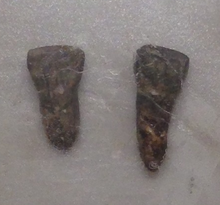
Back رجل يوانمو Arabic Home de Yuanmou Catalan Yuanmou-Mensch German Homo erectus yuanmouensis Spanish انسان یوآنمو Persian Yuanmoun ihminen Finnish Homme de Yuanmou French אדם יואנמואו HE Juanmouski čovjek Croatian 元謀原人 Japanese
| Yuanmou Man Temporal range: Early Pleistocene,
| |
|---|---|

| |
| Casts of the teeth of Yuanmou Man | |
| Scientific classification | |
| Domain: | Eukaryota |
| Kingdom: | Animalia |
| Phylum: | Chordata |
| Class: | Mammalia |
| Order: | Primates |
| Suborder: | Haplorhini |
| Infraorder: | Simiiformes |
| Family: | Hominidae |
| Subfamily: | Homininae |
| Tribe: | Hominini |
| Genus: | Homo |
| Species: | |
| Subspecies: | †H. e. yuanmouensis
|
| Trinomial name | |
| †Homo erectus yuanmouensis Hu et al., 1973
| |
Yuanmou Man (simplified Chinese: 元谋人; traditional Chinese: 元謀人; pinyin: Yuánmóu Rén, Homo erectus yuanmouensis) is a subspecies of H. erectus which inhabited the Yuanmou Basin in Yunnan Province, southwestern China, roughly 1.7 million years ago. It is the first fossil evidence of humans in China, though they probably reached the region by at least 2 million years ago. Yuanmou Man is known only from two upper first incisors presumed to have belonged to a male, and a partial tibia presumed to have belonged to a female. The female may have stood about 123.6–130.4 cm (4 ft 1 in – 4 ft 3 in) in life. These remains are anatomically quite similar to those contemporary early Homo in Africa, namely H. habilis and H. (e?) ergaster.
Yuanmou Man inhabited a mixed environment featuring grassland, bushland, marshland, and forest dominated by pine and alder. They lived alongside chalicotheres, deer, the elephant Stegodon, rhinos, cattle, pigs, and the giant short-faced hyaena. The site currently sits at an elevation of 1,050–1,150 m (3,440–3,770 ft). They manufactured simple cores, flakes, choppers, pointed tools, and scrapers which paralleled the technology of their African contemporaries.
© MMXXIII Rich X Search. We shall prevail. All rights reserved. Rich X Search